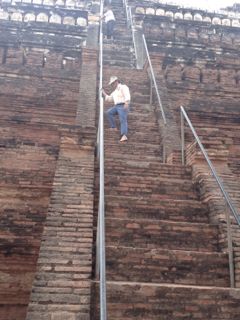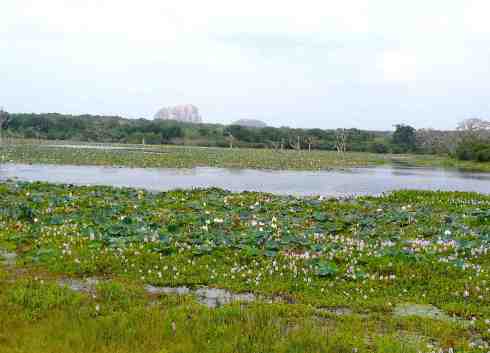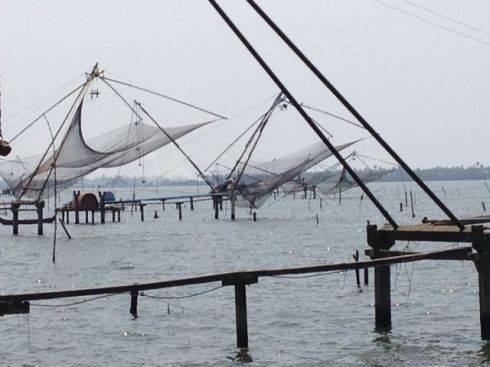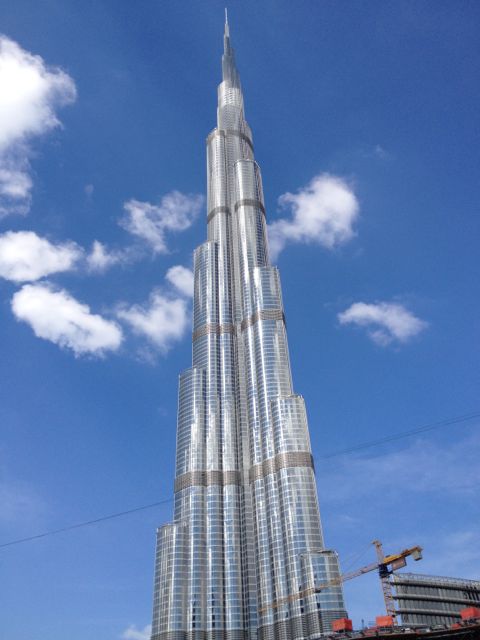 Imagine a string of jagged volcanic islands as a necklace of lushly green gems lying atop a deep blue sea with no blemish of human habitation. This is what greets us as we sail in to the stunning Komodo National Park in Indonesia.
Imagine a string of jagged volcanic islands as a necklace of lushly green gems lying atop a deep blue sea with no blemish of human habitation. This is what greets us as we sail in to the stunning Komodo National Park in Indonesia.
 We are in an area known as Wallacea, an isolated group of islands separated from both the Asian and the Australian spread of flora and fauna. Here evolved such unique spices as the clove and nutmeg—as well as the fierce Komodo dragon.
We are in an area known as Wallacea, an isolated group of islands separated from both the Asian and the Australian spread of flora and fauna. Here evolved such unique spices as the clove and nutmeg—as well as the fierce Komodo dragon.
We’re about to set foot on Komodo Island to trek 90 minutes into the forest in quest of a dragon sighting. The government restricts island access and only guided tours are allowed. Over two thousand of the reptiles roam free to dine on local deer and wild boar.
We’re told strictly that we must stay closely grouped with the three rangers. They’re equipped with long forked sticks to ward off both Komodo dragons as well as the endemic hooded cobra and other venomous snakes. Naturally, two guests walk rapidly ahead and continually ignore that command.
Since dragons are highly attracted to the smell of blood, we’re also told no guests will be allowed ashore if they have open wounds or are menstruating. Next to us is an old woman in sandals sporting open, bloody blisters. “Oh, I thought of wearing a sock but my foot would get too hot.” Maybe we’ll see survival of the fittest at work.
Komodo dragons have a special way of killing. Their saliva is filled with an enormous variety of deadly bacteria. All it takes is one nip and the unlucky deer or boar slowly dies a week or two later from the infections. Then the body is scavenged by multiple lizards who smell putrefying flesh as well as they smell blood.
The jungle walk is hot and sticky. My shirt is soon drenched. The surrounding forest is filled with the sounds of strange birds, but we only occasionally catch the flitting image of wings flying overhead. We spot some deer in the distance, and note the signs of rutting pigs. But no giant lizards yet.
After about two kilometers up and down hills, in and out of shade, we approach a watering hole where lizards like to lay in wait for prey. We sight a group . . . about a half dozen . . . the biggest is about ten feet long and a couple hundred pounds. They eye us lazily (or maybe just the rangers with their sticks); their long forked tongues shoot in and out. We’re told these beasts can run fast, climb trees, and swim, but at the moment they seem as hot and indolent as we feel. They just plod in the sun. Not even the smell of a bloody foot seems to excite them.

But we find them fascinating. Even the always-talking Dutch have quieted down, and our wandering couple has drawn in closer to the group. We are in the presence of something primeval.
This will be our only encounter during our two-hour visit to the island. Other groups reported seeing some young dragons hanging out in a tree (where they hide from their cannibalistic parents), some near the beach (where they sometimes take a swim), and a few scuttling across the forested paths. But we’re happy with our group sighting. We have met and survived our encounter with the fierce dragon!
Robert is taking a breather today; stay tuned for his updates on the next post.
Next: One more stop in Indonesia before returning to Singapore and starting the route back to London.
To check out Dennis’s novels, visit www.amazon.com/author/dennisfrahmann
 Bali—the word carries with it so many connotations of tropical paradise, mystery, and beauty. So I’m sure everyone would expect me to fall in love with it.
Bali—the word carries with it so many connotations of tropical paradise, mystery, and beauty. So I’m sure everyone would expect me to fall in love with it. So far we’ve made two stops in Indonesia on this segment of our Voyage to the Far East: Jakarta and Semarang. In no particular order, here are some of my Indonesian thoughts to date.
So far we’ve made two stops in Indonesia on this segment of our Voyage to the Far East: Jakarta and Semarang. In no particular order, here are some of my Indonesian thoughts to date.
 We’re on a ship filled with people able to afford this rather extravagant three-month trip, and yet Robert and I have managed to find the one thing that ignites their envy.
We’re on a ship filled with people able to afford this rather extravagant three-month trip, and yet Robert and I have managed to find the one thing that ignites their envy. But I’m saving the best for last. The Marina Bay Sands also has three rooftop restaurants overlooking this pool. We call for reservations, and each one is booked until late at night. But remembering friends who taught us that great restaurants often have bars where it’s easier to get seats and still order food, we take a chance. We go to Wolfgang Puck’s Spago restaurant at the top. No problem . . . we’re immediately ushered to two seats at the bar. From our elevated seats, we can look westward through huge open windows toward the Singapore Strait and its hundreds of anchored and sailing ships. Toward the east through the open view is the jagged skyline of the city. Just as we arrive, the sun is setting. As the night darkens, the towers in the distance begin to glow with lights and neon. The western sea is dotted with the floating lights of oil tankers, cargo ships and more until finally the sky and sea meld into a single inky darkness festooned with star points of light.
But I’m saving the best for last. The Marina Bay Sands also has three rooftop restaurants overlooking this pool. We call for reservations, and each one is booked until late at night. But remembering friends who taught us that great restaurants often have bars where it’s easier to get seats and still order food, we take a chance. We go to Wolfgang Puck’s Spago restaurant at the top. No problem . . . we’re immediately ushered to two seats at the bar. From our elevated seats, we can look westward through huge open windows toward the Singapore Strait and its hundreds of anchored and sailing ships. Toward the east through the open view is the jagged skyline of the city. Just as we arrive, the sun is setting. As the night darkens, the towers in the distance begin to glow with lights and neon. The western sea is dotted with the floating lights of oil tankers, cargo ships and more until finally the sky and sea meld into a single inky darkness festooned with star points of light.
 We reached the heart of Myanmar (formerly known as Burma) and the ancient capital area called Bagan. Nearly a thousand years ago, King Anawrahtain started a building craze here for Buddhist temples. Today over 2,200 pagodas, temples and monasteries remain from that era, many as archeological ruins, dotting about twenty square miles. Literally, you could barely throw a stick without hitting one.
We reached the heart of Myanmar (formerly known as Burma) and the ancient capital area called Bagan. Nearly a thousand years ago, King Anawrahtain started a building craze here for Buddhist temples. Today over 2,200 pagodas, temples and monasteries remain from that era, many as archeological ruins, dotting about twenty square miles. Literally, you could barely throw a stick without hitting one. In addition to the abandoned sites, a few of the temples remain active places of worship. Their spires are often covered in gold leaf, their hallways filled with locals, and the sense of bustle is punctuated by the occasional striking of a gong. These major temples were beautiful and interesting, but for some reason, I remain drawn to the lost past—so for me, the wonders of Bagan will always be the abandoned ruins stretching across the grasslands. It was sad to say good-bye. Maybe one day, I will get a chance for a return visit.
In addition to the abandoned sites, a few of the temples remain active places of worship. Their spires are often covered in gold leaf, their hallways filled with locals, and the sense of bustle is punctuated by the occasional striking of a gong. These major temples were beautiful and interesting, but for some reason, I remain drawn to the lost past—so for me, the wonders of Bagan will always be the abandoned ruins stretching across the grasslands. It was sad to say good-bye. Maybe one day, I will get a chance for a return visit. As we gaze across the lake filled with water lilies and hyacinths toward Elephant Rock in Yala National Park outside Hambantota, Sri Lanka, Robert and I feel good.
As we gaze across the lake filled with water lilies and hyacinths toward Elephant Rock in Yala National Park outside Hambantota, Sri Lanka, Robert and I feel good.
 Our introduction to India has been a pair of stops in southern India, visiting the port cities of Mangalore and Kochi (formerly Cochin). This India experience has been a study of contrasts—Mangalore at first bored me with its sense of muddled respectability; Cochin excited me with its air of exotic.
Our introduction to India has been a pair of stops in southern India, visiting the port cities of Mangalore and Kochi (formerly Cochin). This India experience has been a study of contrasts—Mangalore at first bored me with its sense of muddled respectability; Cochin excited me with its air of exotic.
 Remember those dioramas of the future from places like the GM Pavilion at the New York World’s Fair or the Carousel of Progress at Disneyland? Lots of tall skyscrapers, broad avenues, and elevated railways zipping people to and fro.
Remember those dioramas of the future from places like the GM Pavilion at the New York World’s Fair or the Carousel of Progress at Disneyland? Lots of tall skyscrapers, broad avenues, and elevated railways zipping people to and fro.

